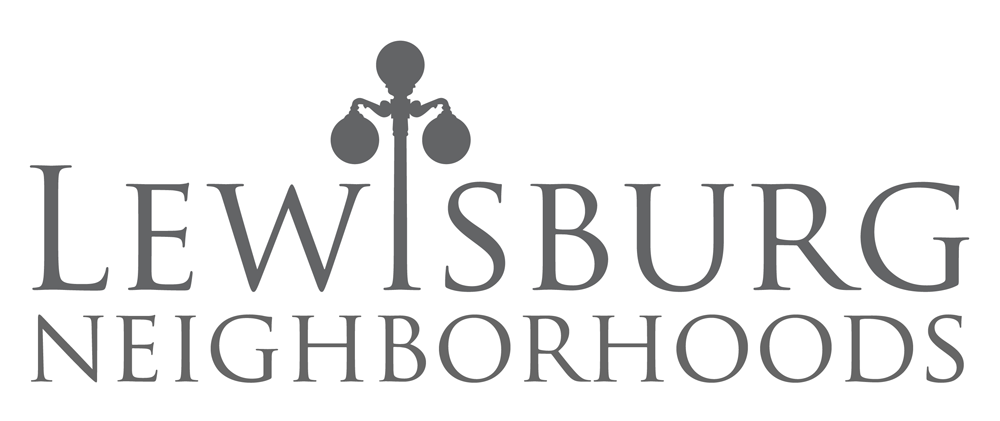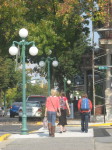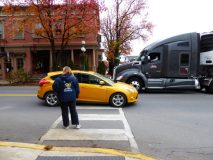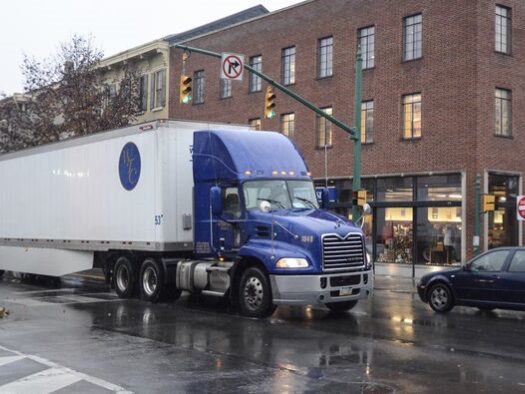The Borough of Lewisburg will be hosting a Public Meeting on Tuesday, April 23rd at 6:30pm at the Iron Front Event Space at 434 Market Street #301 of the Chamberlain Building in Downtown Lewisburg.
The consultant team from Traffic Planning and Design (TPD) will be explaining the project scope and methods of data collection as well as early observations from their initial research and monitoring of the Market Street corridor. TPD is contracted by the Borough to analyze traffic volumes and speeds, examine safety and public health issues as well as environmental conditions such as noise, vibrations, and pavement condition. Commercial business activity and overall economic health is also part of this comprehensive study.
Feedback from the public will be sought at the meeting through table exercises, prioritization tasks, and short surveys.
The study is expected to be completed in June with a final presentation to the Borough Council, open to the public, on June 11.
See below for the FAQs initially circulated during the lead up to the issuance of an RFQ for the study. For questions about the project and the upcoming public meeting, please contact the Borough's Special Projects Coordinator, Kim Wheeler, at kwheeler@lewisburgborough.org or 570-523-3614 x 311.
TRANSPORTATION AND SAFETY STUDY
FOR MARKET STREET
IN LEWISBURG’S HISTORIC DISTRICT
- What is the significance of Market Street in Lewisburg’s Historic District?
Lewisburg’s Market Street is a historic street, laid out in 1785, and originally built to traditional proportions and human scale. It was designed to provide convenient access to commercial, residential, educational, religious, and other social spaces. Today, Market Street passes through a heavily-developed, highly pedestrian business and residential area that represents Lewisburg’s densest development. It is enclosed by a tight envelope of iconic and irreplaceable historic buildings that are located in a vibrant and nationally-recognized 250 year-old central Pennsylvania town, which serves as a regional cultural and business center.
- What is the area of focus for the “Market Street Transportation and Safety Study”?
The specific area to be studied encompasses a nine (9) block section of Market Street (PA Route 45) through Lewisburg’s Historic District and downtown commercial and residential area, from the Market Street Bridge to the intersection of Market Street and US Route 15. The Study will evaluate the regional context of the 9-block Market Street Corridor, including such topics as human and natural resources, projected growth in population, commerce, industry, development, transportation networks, and freight movements and depots.
- Why is the “Market Street Transportation and Safety Study” necessary?
Over the last several decades, due to the growth of commerce and transportation networks in the region, the Historic Market Street Corridor in downtown Lewisburg has experienced an increasing amount of “through vehicular traffic.” Specifically, this Corridor has been impacted by a significant number of over-sized and heavy vehicles, often carrying hazardous and toxic materials. These vehicles, which could choose alternative routes especially designed to safely accommodate them, elect to travel through the highly-pedestrian area of Lewisburg’s Historic Downtown. This year-over-year increase of large vehicular traffic through the Market Street Corridor in Lewisburg’s Downtown Historic District poses public safety, public health, environmental, and “quality of life” impacts to residents, students, and visitors. It also disrupts thriving businesses, threatens historic buildings, and impacts Lewisburg’s parks, greenways, and natural resources. There is nothing in current or future transportation planning that is “specifically” designed to address the projected increase of such large “pass through” vehicles on Market Street in the Historic District. In order for Lewisburg stakeholders to be part of “current and future transportation conversations, planning, and solutions,” this Market Street Transportation and Public Safety Study for the Historic District must be completed.
- What are some of the most noticeable impacts of the current traffic situation along Market Street?
The Market Street Historic Corridor is used by pedestrians, hikers, bikers, vehicles of all types, and is crossed by trains. Of particular concern, is the safety and well-being of children, seniors, and persons with disabilities. The Buffalo Valley Rail Trail soon will cross Market Street, between Fifth and Sixth Streets, to link downtown with the Bucknell campus. Once large vehicles enter the Market Street Corridor from either end, it is extremely difficult for them to turn right or left or “pull-over” for emergency vehicles, fire trucks, or police, or due to their own breakdowns or driver incapacitations. This situation negatively affects the ability of our “first responders” and “emergency management operations,” to serve and protect our community. The increased vehicular “through traffic,” and most especially large, heavy vehicles, has led to rising noise levels and deteriorating air quality in downtown Lewisburg. Constant vibrations from these vehicles have caused mortar to loosen, plaster to crack, and architectural features to dislodge from Lewisburg’s irreplaceable historic buildings. Parked vehicles have been damaged by these large vehicles attempting to navigate the narrow Market Street Corridor. These conditions have created an inhospitable environment for residents, visitors, and shoppers, and there has been a noticeable decrease in patrons of downtown businesses.
- Why does Lewisburg’s Historic District deserve special attention?
Lewisburg is an historic central Pennsylvania town, dating back to the late 1760’s. The traditionally laid-out streets, alleys, blocks, and structures within the Historic District are protected by Borough Ordinance. Lewisburg’s Historic District, with its 853 historic buildings, is recognized both on the National Register of Historic Places and by the Pennsylvania State Bureau for Historic Preservation. These architecturally-significant homes, public, and commercial buildings represent every type of architectural style prominent between 1750 and 1974--Packwood House Museum (1796), Union County Courthouse (1855), Reading Railroad Station (1884), Federal Post Office (1935), Chamberlain Iron Front Building (1868), and the Art Deco Campus Theater (1941). These iconic buildings, constructed across a nearly 250-year period, are a “living museum” of history and architecture that embraces Lewisburg’s vibrant contemporary business, residential, and social community.
- What does Lewisburg stand to lose if we do nothing?
Historic Lewisburg is a national treasure, a regional draw, a local business and social center, and an east coast destination, enhanced by its more than 154 small businesses. The charm and vitality of Downtown Lewisburg attracts people to live, work, visit, and play. It is an educational, commercial, banking, recreational, and cultural destination that has preserved, across centuries, its architectural and cultural heritage, the human scale of its built and natural environment, and its contemporary appeal and offerings. Tens of thousands of visitors each year come to experience Lewisburg’s unique sense of place. This is our competitive advantage. If we should lose the very reasons for our longevity and success and the features that set us apart from “anywhere USA,” we not only lose the appeal of Lewisburg’s Downtown Historic District for current and future residents, visitors, and businesses, but we will witness the decline of our viability and our economy.
- What are the “Goals and Outcomes” of the “Market Street Transportation Study in the Historic District”?
The study will provide a “professional transportation engineering assessment” of the impacts described above, such as increased vehicular traffic, transportation of hazardous materials, passenger vehicle safety, pedestrian safety and welfare, especially for seniors, children, and the disabled, and bike safety, along with evaluation of public health issues and the sustainability of environment assets and historic structures. It will also present “recommendations for workable solutions and action items” that will serve to address public safety, public health, environmental and transportation concerns along Market Street, with the goal of maintaining Lewisburg’s Downtown Historic District, as a safe, walkable, and healthy community that will flourish and protect its residents, visitors, and businesses for the next 250 years.
- Why should this study matter to you?
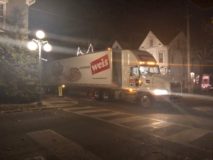 If you live in the Lewisburg zip code, you undoubtedly are positively impacted by the beauty and vitality of Downtown Lewisburg. In addition to its contribution to the tax base, the Historic District hosts year-round events and activities. These events thrive, because Downtown businesses and residences along Historic Market Street have, for generations, created a vibrant and positive social space. Many people who value having a safe, walkable, and healthy Downtown Lewisburg Community that will continue to flourish and serve our future generations, have contributed to make this study come to pass. If you were one of the contributors, THANK YOU! If you haven't contributed yet, you can still help out by providing your input and feedback at the public meeting on April 23.
If you live in the Lewisburg zip code, you undoubtedly are positively impacted by the beauty and vitality of Downtown Lewisburg. In addition to its contribution to the tax base, the Historic District hosts year-round events and activities. These events thrive, because Downtown businesses and residences along Historic Market Street have, for generations, created a vibrant and positive social space. Many people who value having a safe, walkable, and healthy Downtown Lewisburg Community that will continue to flourish and serve our future generations, have contributed to make this study come to pass. If you were one of the contributors, THANK YOU! If you haven't contributed yet, you can still help out by providing your input and feedback at the public meeting on April 23.
